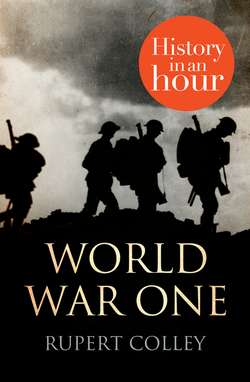Читать книгу World War One: History in an Hour - Rupert Colley - Страница 10
ОглавлениеThe War in Britain
Britain had a problem with men – not enough of them. The BEF, the professional army, was too small but the British, unlike its European counterparts, were against conscription. The answer was to raise an army of volunteers. The Secretary of State for War, Field Marshal Lord Horatio Kitchener, went on a recruitment drive. Throughout the country from 7 August 1914, posters adorned with his stern-looking face and pointing finger shouted out, ‘Your Country Needs You’.
Lord Kitchener’s recruitment poster, 1914
Kitchener and the government hoped for perhaps 100,000 volunteers within the first six months. Any more would cause logistical problems. In the event, they got two million by the end of 1915, such was the extent of British patriotism and British naivety. But these young men were not to blame for their ignorance – news reporting was severely censored and war reporters were barred from the front. Thus, speculation and rumour made up for where fact lacked. A million Russian troops had landed in Scotland and were marching through England – you could see the snow on their boots; the barbaric Germans had tied Belgium nuns to church bells and used them as clappers; and the corpses of German soldiers were being used by the Germans to make candles and boot polish.
Volunteers for Kitchener’s Army, Trafalgar Square, August 1914. IWM Collections, Q 53234
While men signed up, women took their jobs in factories, on farms, public transport, postal services, and businesses. The war, arguably, advanced the cause of women’s liberation far more than the pre-war suffragette movement. Recognizing the role women played during the war, the British government passed two laws in 1918 that, between them, gave women over thirty the right to vote, and allowed women to stand as Members of Parliament.
Women at work in a munitions factory, c. 1915
On 27 January 1916, the recruiting of volunteers in Britain came to an end, replaced by conscription. Initially affecting only single men, by May the draft was extended to include married men.
The replacement of the initial mood of optimism with a growing realization of the true horror of modern warfare, is perhaps best reflected in the works of the War Poets. At first, poems extolled the glory of war and the virtues of defending one’s country. Rupert Brooke epitomized the early enthusiasm for war in his sonnet ‘Now God be thanked who has matched us with His hour’. Julian Grenfell, a captain in the British army, wrote in a letter, ‘I adore war. It is like a big picnic but without the objectivelessness of a picnic’. His poem, ‘Into Battle’, in which he wrote of the ‘joy of battle’, was published in The Times on the day of his funeral in May 1915.
Bitterness soon crept in. Siegfried Sassoon, an early enthusiast for the war, had received the Military Cross and was nicknamed Mad Jack for his courageous feats. While recovering from shellshock in Craiglockhart hospital in Scotland, Sassoon wrote of the ‘rank stench of those bodies [that] haunts me still’. Sassoon befriended a fellow patient, Wilfred Owen, who summed up his generation’s disillusionment with war in his poem, ‘Dulce et Decorum est’: ‘You would not tell with such high zest to children ardent for some desperate glory, / The old Lie: Dulce et Decorum est / Pro patria mori’ (‘it is sweet and right to die for your country’). Owen was killed in action a week before the Armistice.
Spies, according to the fevered public imagination, were everywhere – you could spot German spies dressed as nuns by their hairy legs. Genuine Germans were interned on the Isle of Man. Anti-German sentiment ran deep – shops with Germanic-sounding names were attacked, dachshunds, according to popular legend, kicked in the street. Even the Royal Family was not immune, changing its name from Saxe-Coburg-Gotha, a bit of a German giveaway, to Windsor.
In Belgium, English nurse Edith Cavell was caught smuggling wounded Allied soldiers into neutral Netherlands. Despite appeals for clemency, Cavell was executed on 12 October 1915 by firing squad. Cavell had freely admitted her guilt for a crime that carried the death penalty, but the British government seized on the propaganda advantage Cavell’s death provided – the heroic nurse murdered by the German barbarian. Another infamous execution was that of Gertrud Margarete Zelle, an exotic Dutch dancer and performer better known by her stage name, Mata Hari. Accused by the French of being a double agent, she was shot in October 1917.
Hatred of all things German intensified when, on 19 January 1915, German zeppelins bombed Great Yarmouth in East Anglia, killing four people. The first raid on London, on 31 May, killed seven. War had come to England. Compared with the next war, these attacks were few and infrequent, limiting the damage. In total, 557 British civilians lost their lives from bombing throughout the war.
More shocking perhaps was the sinking of the British Cunard cruise liner, the Lusitania off the coast of County Cork, Ireland. Hit by a German U-boat on 7 May 1915, the ship sunk in just eighteen minutes. 1,198 of its 1,959 passengers and crew were killed, of whom 128 were American. The attack on a civilian ship caused outrage but the ship had been carrying a large supply of ammunition and, therefore, in German eyes, made her a legitimate target.
